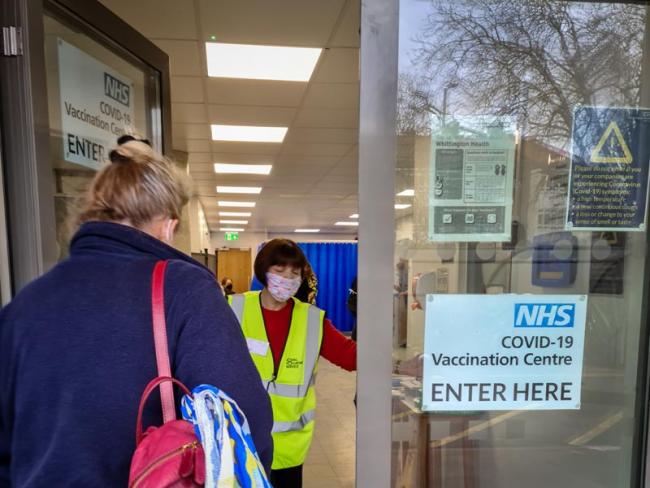
Covid vaccinations: one of the areas where the Science Media Centre held briefings. Photo Yau Ming Low/shutterstock.com.
Issues around science are often high up in the news agendas, but many players can be involved in bringing a story to the public…
Beyond the Hype – The Inside Story of Science’s Biggest Media Controversies, by Fiona Fox, hardback, 256 pages, ISBN 978-1783966172, Elliot & Thompson, 2022, £16.99 or less. Kindle and eBook editions available; paperback edition due February 2023.
This book is worth reading for anyone who is interested in the way that science and scientific ideas are used, and abused. Fiona Fox takes examples from her 20 years’ experience to illustrate the way that science stories appear in the mass media.
Significant misrepresentations of science and medicine happened well before the coronavirus pandemic brought science communication to wider attention. Such health scares and other unscientific myths can be misleading, and often damaging.
‘Fish genes’
For example, the campaign by Greenpeace and others against genetically modified crops in the 1990s described them pejoratively as “Frankenfoods” – and falsely claimed that “fish genes” were inserted in commercially grown tomatoes.
Far worse was how one renegade doctor Andrew Wakefield and the uncritical media coverage of his fraudulent 1998 Lancet paper did profound damage to the MMR vaccine programme – and to the long-term trust in vaccines generally.
There were other controversial science stories at around the same period about topics such as BSE, cloning and the management of nuclear waste. Against this background the House of Lords Science & Technology Select Committee published a report in 2000 which concluded that public trust in scientific advice given to the government was in a state of crisis.
The Science Media Centre (SMC) is an independent press office, founded in 2002 in response to this situation. It seeks to provide “for the benefit of the public and policymakers, accurate and evidence-based information about science and engineering through the media, particularly on controversial and headline news stories when most confusion and misinformation occurs”.
Fiona Fox, the SMC’s founding director, wrote this book to mark its 20th anniversary. Nine of the eleven chapters cover a scientific controversy that surfaced during that period. The other two tackle topics of science communication.
The focus is on the work of the SMC and the many players and stages involved before a science story gets media coverage and reaches us, the public. Inevitably some of the language is technical but Fox explains clearly where necessary. Her explanation of human hybrid embryos and stem cell research is particularly helpful.
Each chapter is interesting on its own, but two common threads run throughout. First, the importance of scientists engaging with the media to explain their work and encourage accurate media coverage. And secondly, the benefit to the population and to scientific research and development when this occurs.
Fox gives many examples of the work and efforts made to change the previous culture among scientists. They generally avoided contact with the media – which often led to unease or distrust among non-scientists. But she has not written a sugar-coated account. The book conveys a sense of “one step forward, two steps back’” and the continued need for vigilance.
Chronic fatigue
One chapter tells a sorry tale about research into myalgic encephalomyelitis, otherwise known as chronic fatigue syndrome (ME/CFS). By the early 2000s Simon Wessely, a researcher who helped develop the first therapies and NHS clinics in treating ME/CFS, was routinely receiving death threats and threatening calls.
The SMC has had little success to date in rolling back attacks on scientists involved on research into ME/CFS – who are reluctant to raise their heads above the parapet and, for many, are unwilling to continue research in the field.
‘Some journalists decried the mixed messaging on the vaccination of children…’
Fox writes, “Thankfully the situation with ME/CFS is extraordinary and rare. But the principles involved are not. My real worry is that the collective failure of the medical research establishment to step into this row to publicly support the scientists, defend a body of evidence, and argue that we need all kinds of research to tackle this devastating illness will pave the way for the same thing to happen in other areas of science.”
The final chapter covers the Covid pandemic, including the Joint Committee on Vaccination and Immunisations (JCVI) decision in summer 2021 not to recommend vaccinating children.
Fox outlines the reasons for this; she states that this was an independent advisory committee working exactly as it should. She advised the JCVI to arrange its own press briefing to explain its recommendations, whilst stressing that it would be equally valid for the government to reach a different conclusion.
The JCVI briefing took place. A few days later the chief medical officers reported their advice to vaccinate children and the government announced that this would happen within a few days.
Some journalists decried the mixed messaging, but Fox argues that because of the press briefings most took on board the reasons for the different approaches and their reporting was balanced. In her view it was an important step for independent scientists to communicate the reasons for their decision and the government to explain why it had decided not to follow it.
No doubt these differences made it harder for many parents and children to decide on whether to take the vaccine. But Fox points out that many media interviews at the time showed that people understood this was a complex issue.
Fox frequently says that science is “messy”, but that the scientific method is hugely valuable. Her hope, expressed in the introduction, is that her book is compelling reading for anyone interested in some of the big contemporary science questions or in the complex interaction of science with politics, culture, and society at large. She has undoubtedly achieved that aim.
